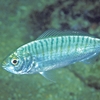General Description
Body extremely flattened with both eyes on the left side of the head, two pelvic fins, pelvic fin on eyed-side with a longer base than that on blind side; dorsal and anal fins separate from tail. Eyed-side brown with variable dark and pale spots and speckles, usually with large dark spots on midside. Difficult to distinguish from the Bass Strait Flounder, Arnoglossus bassensis, which also lives in Victorian coastal waters. Mueller's Flounder has slightly larger scales and eyes, and appears to be more common. To 21 cm.
Biology
Appears to be more common than related species that occupy the same shelly, sandy habitats.
Habitat
Broken shelly and sandy bottoms, in 5-200 m.
Soft substrates
Distribution guide
Southern Australia.
Species Group
Fishes › Flatfishes and flounders
Depth
Shallow (1-30 m)
Deep ( > 30 m)
Water Column
Max Size
21 cm
Diet
Carnivore
Commercial Species
No
Global Dispersal
Native to Australia
Conservation Status
- DSE Advisory List : Not listed
- EPBC Act 1999 : Not listed
- IUCN Red List : Not listed





